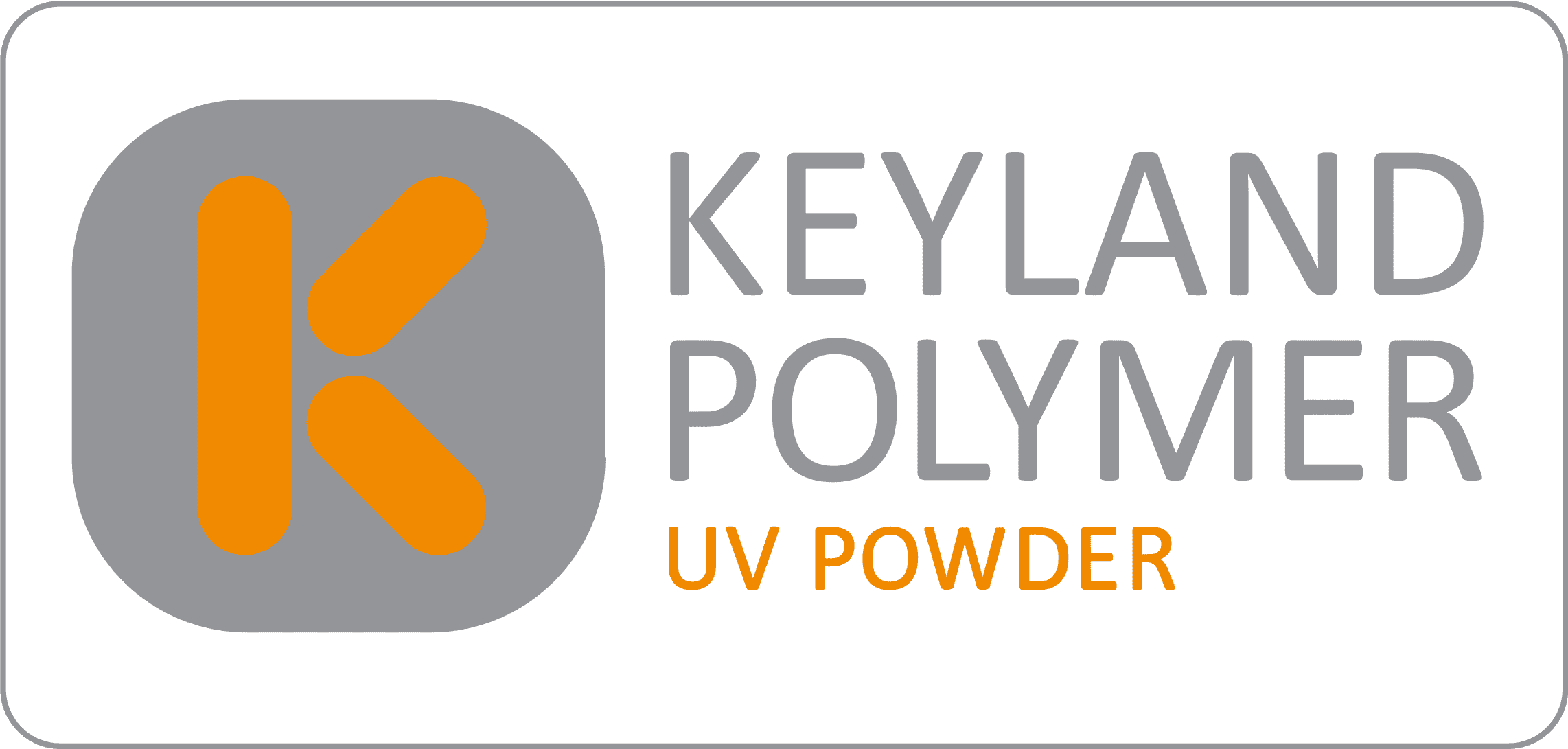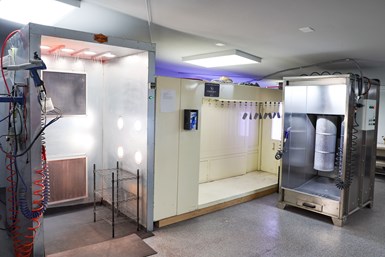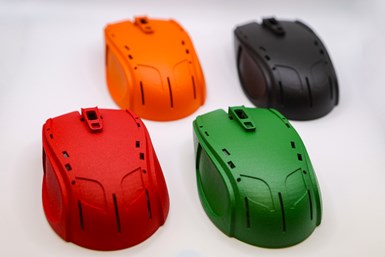Finishing Additively Manufactured Parts With UV Powder Coating
Streamline 3D’s approach to custom finishes, and a focus on aesthetics and functionality, is driving customer satisfaction and expanding the horizons of additive manufacturing.
Products Finishing November 2025 Vol 90 No 2
Author: Scott Francis, Editor-in-Chief

Scalable color options for 3D printed parts have been a significant challenge in the industry. Streamline 3D has partnered with UV-curable powder coatings company Keyland Polymer, to offer customers a range of options. Source (All Images) Streamline 3D
In the rapidly evolving world of additive manufacturing (AM), Streamline 3D, based in Fresno, California, has carved out a unique niche by combining cutting-edge 3D printing technology with advanced finishing solutions. Founded by Cody Laursen, the company has grown from a small side gig into a key player in the industrial 3D printing space over the past decade, with the last four years under the Streamline 3D banner marking significant strides in production capabilities and customer-focused innovation.
A recent interview with Laursen sheds light on how Streamline 3D is redefining the possibilities of 3D printed parts through its partnership with powder coating supplier Keyland Polymer (Cleveland, Ohio) and a shared commitment to aesthetics and functionality in finishing.
From humble beginnings to high-tech production
Streamline 3D’s journey began 10 years ago with basic fused deposition modeling (FDM) printing, using desktop machines that were, at the time, relatively uncommon. What started as a side project evolved into a full-fledged business when Laursen founded Streamline 3D. After extensive market research and leveraging industry contacts, the company invested in multi jet fusion (MJF) technology, specifically the HP 5200, which offered greater part quality and accuracy for end-use applications — unlike earlier 3D printing methods primarily suited for prototyping.
“We gave ourselves a good budget and did a bunch of market research,” Laursen recalls. “Pretty much everybody told me that MJF was the technology to get into. It was newer, more production-focused and the parts were good enough for end use.”
Today, Streamline 3D operates four MJF systems, with plans for a fifth, and specializes in PA12 nylon, which constitutes 95% of the production 3D printing market. The company offers two variations of PA12, including a smooth material introduced by HP Inc. (Palo Alto, California) in March 2024, of which Streamline 3D is reportedly one of the largest users in North America, if not globally.
Streamline 3D’s sweet spot lies in low- to medium-volume production, typically ranging from 10 to a few hundred parts per order, catering primarily to contract manufacturers and assemblers who integrate these components into larger products. Key markets include automotive — especially early alpha and beta builds for electric vehicles (EVs) and low-volume, high-value vehicles like specialized semi-trucks and industrial equipment — along with medical devices, electronics housings and niche applications like racecar components.
Finishing as a competitive edge
From its inception, Streamline 3D recognized that finishing is as critical as the printing process itself. “A lot of our customers are very passionate about their product,” Laursen explains. “They want their parts to look a certain way — smooth, mirror finish, matte, rough, shiny, colored. Sometimes they need specific material properties to make the parts stronger or more flexible. You can do a lot of that in postprocessing.”
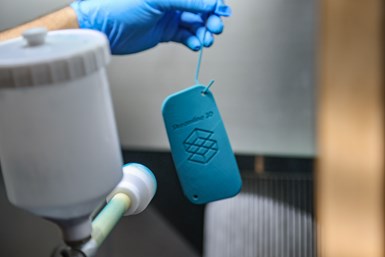
Powder coating offers more color options, shorter cure times and is more eco-friendly than many liquid coating approaches.
The company offers eight to 10 different finishes, some of which are proprietary, developed in-house to meet unique customer demands. These finishes not only enhance aesthetics but also provide functional benefits. For instance, shot peening compacts the surface to prevent scratching, vapor smoothing seals surfaces for moisture resistance and flexibility, and Cerakote offers durability for outdoor use and scratch resistance. This dual focus on form and function has fostered a loyal, recurring customer base, as Streamline 3D often provides solutions unavailable elsewhere.
“Aesthetics is probably the number one thing,” Laursen notes. “They [our customers] open the box, and in the first half-second they’ve already judged whether they want to buy from us again based on how the part looks.” This customer-driven approach has been a cornerstone of the company’s success, ensuring that parts not only meet technical specifications but also exceed visual expectations.
Revolutionizing color with UV powder coating
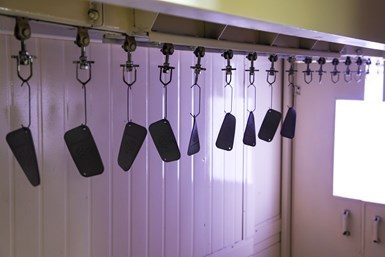
UV powder coating melts and flows at a lower temperature around 220°F and cures instantly after UV light exposure, making it compatible with heat sensitive substrates.
One of the most significant challenges in industrial AM has been achieving consistent, scalable color options for 3D printed parts. Traditional methods like dyeing MJF parts (limited to gray or black) or using liquid paints like Cerakote were either inconsistent, slow or prone to high scrap rates due to handling issues and long cure times. Streamline 3D sought a better solution, leading to a transformative partnership with Keyland Polymer, a company specializing in UV-curable powder coatings.
“Pretty much everything comes in the color that it prints,” Laursen says. “There was really no way to get a quality 3D printed part that scales in a color you actually want.” Cerakote, while effective for some applications, was labor-intensive and costly, often requiring multiple coats and resulting in frequent defects.
The introduction of Keyland Polymer’s UV powder coating technology changed the game. Unlike traditional powder coatings that require high temperatures and long cure times — often incompatible with heat-sensitive plastics like PA12 — UV powder coatings are formulated to melt and flow at a lower temperature (around 220°F). After this melt and flow stage, the UV powder coating is instantly cured when exposed to UV light, dramatically reducing the heat exposure to the part. Total process time from raw part to finishes is 8 minutes. This process, developed in collaboration with Keyland Polymer, enables Streamline 3D to offer vibrant, consistent colors with a low scrap rate and high scalability, processing hundreds to thousands of parts daily.
“We’re doing in one day what would take us a week or longer with Cerakote, and getting better quality,” Laursen enthuses. The environmental benefits of powder coating over liquid paints also appeal to larger clients with sustainability mandates, though Laursen notes that smaller customers prioritize quality and cost over eco-friendliness.
Custom solutions, collaborative innovation
Implementing UV powder coating required Streamline 3D to design a custom production line, a process in which it collaborated closely with Keyland Polymer to determine parameters like temperature, UV curing equipment and cooling needs. Laursen and his team took on the heavy lifting of designing and building the system — a continuous overhead conveyor line shaped like a large oval. Parts move through an oven for even heating, rotate in front of a UV lamp for curing and emerge ready for packaging — all without stopping.
“It took maybe four months to design, build and have the machine shipped to us,” Laursen says. In production for just four months, the line has already handled orders of thousands of parts, achieving turnaround times of a few days compared to weeks or months with traditional methods. A recent order of several thousand parts was completed at a rate of about 100 parts per hour, with results Laursen describes as “absolutely gorgeous.”
The process is not without limitations — custom color matching requires a longer lead time for powder formulation and powders cannot be easily reclaimed on this system design, though it is something that is being explored. Currently, the advantages far outweigh any drawbacks. “We’ve converted pretty much all of our Cerakote customers to powder coating,” Laursen reports. “Over the four months we’ve been doing this, we’ve never had anybody go back to Cerakote for any reason.”
Looking ahead
Streamline 3D’s partnership with Keyland Polymer exemplifies how innovation in finishing can expand the horizons of AM. By addressing the longstanding challenge of coloring 3D printed parts, the company is paving the way for broader adoption of these technologies in industries ranging from automotive to medical devices.
The skepticism Laursen often encounters — many are unaware that UV powder coating on plastics is possible — underscores the pioneering nature of this work. “We have to convince people that it’s possible,” Laursen says. “They’re like, ‘No, you didn’t powder coat these.’ But we solve those problems. It is possible.”
With plans to add more colors to its UV powder coating palette and further enhance production capabilities, Streamline 3D continues to refine its processes and expand its offerings, including experimental work with fiber-reinforced materials like Markforged’s Onyx. Putting an emphasis on finishing processes and achieving the best end product possible is part of the company’s formula for pushing boundaries through innovation and collaboration, and positioning itself as a leader in the industry.

